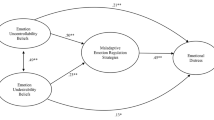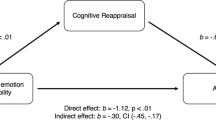Abstract
People hold divergent beliefs regarding the controllability of their emotions. These beliefs can refer to emotion, in general, or to a particular emotion. But are beliefs about particular emotions distinct and emotion-specific or do they capture one general construct? To address this question, in this investigation, we tested the emotion-specificity of such beliefs. In Study 1 (N = 244), we assessed beliefs about the ability to control sadness, anger, and disgust, cross-sectionally. Beliefs about the ability to control specific emotions were associated but psychometrically distinct. As expected, beliefs about the ability to control a specific emotion were largely associated with experiences of that emotion at both the trait and state levels, although there was some overlap. In Study 2 (N = 157), we tested beliefs about the ability to control sadness and irritation in daily life, over 7 daily diaries. As expected, beliefs about the ability to control a specific emotion were associated with the respective trait emotion, and prospectively and differentially predicted experiences of that emotion in daily life. These findings demonstrate that although there is some commonality across them, beliefs about the ability to control particular emotions are emotion-specific. Accordingly, to better understand the experience and regulation of specific emotions, it may be useful to assess beliefs about the controllability of those emotions, in particular.


Similar content being viewed by others
Data availability
All the data reported in the present manuscript, as well as the Supplemental Materials, are publicly available via Open Science Framework, and can be accessed now at: https://osf.io/4fk63/?view_only=8c387424ca4e460ba5aff88685721f99.
Notes
All the data reported in the present manuscript, as well as the Supplemental Materials, are publicly available via Open Science Framework, and can be accessed at: https://osf.io/4fk63/?view_only=932b3ecd5299483cb9dbd58ba5dd9979.
Data in all studies were collected as part of larger studies designed to answer multiple research questions (see descriptions in Supplemental Materials). We only report variables relevant to this project.
As another proxy for trait sadness, we also measured neuroticism. Analyses with neuroticism are reported in the Supplementary Materials.
We repeated these analyses using only the sadness item. Results remained unchanged, such that beliefs about the ability to control sadness were associated with state sadness (Estimate [SE] = − 0.22 [0.08], 95% CI [− 0.37 to − 0.07], p = .004), and with trait sadness (Estimate [SE] = − 0.27 [0.06], 95% CI [− 0.39 to − 0.16], p < .001).
Due to the low reliability of the state disgust scale, we repeated this analysis using only the disgust item. Results remained unchanged, such that beliefs about the ability to control disgust were not associated with state disgust [Estimate (SE) = − 0.08 [0.05], 95% CI [− 0.18 to 0.03], p = .151).
The 9-day study included a pre-diary assessment, 7 days of diaries, and a post-diary assessment. Of the original 166 participants, 70.5% completed all 9 days, 7.8% completed 8 days, 6.6% completed 7 days, 5.4% completed 6 days, and 4.2% completed 5 days. Nine participants (5.4%) completed 4 days or less, and thus were excluded from the analyses. Participants completed on average 8.16 surveys (SD = 1.58).
We repeated these analyses using only the sadness item. Results remained unchanged, such that beliefs about the ability to control sadness were associated with state sadness [Estimate (SE) = − 7.41 (1.02), 95% CI (− 9.41 to − 5.42), p < .001], and with trait sadness [Estimate (SE) = − 0.26 (0.09), 95% CI (− 0.44 to − 0.09), p = .004].
References
Atkinson, J. W. (1957). Motivational determinants of risktaking behavior. Psychological Review, 64, 359–372.
Bates, D., Maechler, M., Bolker, B., & Walker, S. (2015). Fitting linear mixed-effects models using lme4. Journal of Statistical Software, 67(1), 1–48. https://doi.org/10.18637/jss.v067.i01
Berking, M., & Wupperman, P. (2012). Emotion regulation and mental health: Recent findings, current challenges, and future directions. Current Opinion in Psychiatry, 25(2), 128–134.
Bolger, N., & Laurenceau, J. P. (2013). Intensive longitudinal methods: An introduction to diary and experience sampling research. Guilford Press.
De Castella, K., Goldin, P., Jazaieri, H., Ziv, M., Dweck, C. S., & Gross, J. J. (2013). Beliefs about emotion: Links to emotion regulation, well-being, and psychological distress. Basic and Applied Social Psychology, 35(6), 497–505.
De Castella, K., Goldin, P., Jazaieri, H., Ziv, M., Heimberg, R. G., & Gross, J. J. (2014). Emotion beliefs in social anxiety disorder: Associations with stress, anxiety, and well-being. Australian Journal of Psychology, 66(2), 139–148.
Dweck, C. S., Chiu, C. Y., & Hong, Y. Y. (1995). Implicit theories and their role in judgments and reactions: A world from two perspectives. Psychological Inquiry, 6, 267–285.
Faul, F., Erdfelder, E., Lang, A. G., & Buchner, A. (2007). G* Power 3: A flexible statistical power analysis program for the social, behavioral, and biomedical sciences. Behavior Research Methods, 39, 175–191.
Ford, B. Q., & Gross, J. J. (2019). Why beliefs about emotion matter: An emotion-regulation perspective. Current Directions in Psychological Science, 28(1), 74–81.
Ford, B. Q., Lwi, S. J., Gentzler, A. L., Hankin, B., & Mauss, I. B. (2018). The cost of believing emotions are uncontrollable: Youths’ beliefs about emotion predict emotion regulation and depressive symptoms. Journal of Experimental Psychology: General, 47, 1170–1190.
Gross, J. J., Richards, J. M., & John, O. P. (2006). Emotion regulation in everyday life. In D. K. Snyder, J. A. Simpson, & J. N. Hugues (Eds.), Emotion regulation in couples and families: Pathways to dysfunction and health (pp. 13–35). American Psychological Association.
Gutentag, T., Oliver, J., Gross, J. J., & Tamir, M. (2020). Incremental theories of emotion and intelligence across time: Temporal dynamics and correlates of change. Emotion. https://doi.org/10.1037/emo0000945
Haidt, J., McCauley, C., & Rozin, P. (1994). Individual differences in sensitivity to disgust: A scale sampling seven domains of disgust elicitors. Personality and Individual Differences, 16(5), 701–713.
Hair, J. F., Anderson, R. E., Tatham, R. L., & Black, W. C. (1995). Multivariate data analyses with readings. Englewood Cliffs.
Hayes, S. C., Pistorello, J., & Levin, M. E. (2012). Acceptance and commitment therapy as a unified model of behavior change. The Counseling Psychologist, 40(7), 976–1002.
Hughes, J. S. (2015). Support for the domain specificity of implicit beliefs about persons, intelligence, and morality. Personality and Individual Differences, 86, 195–203.
IBM Corporation. (2012). IBM SPSS statistics for Windows, version 21.0. IBM Corp.
Kappes, A., & Schikowski, A. (2013). Implicit theories of emotion shape regulation of negative affect. Cognition & Emotion, 27(5), 952–960.
King, R. B., & Dela-Rosa, E. D. (2019). Are your emotions under your control or not? Implicit theories of emotion predict well-being via cognitive reappraisal. Personality and Individual Differences, 138, 177–182.
Kneeland, E. T., & Dovidio, J. F. (2019). Emotion malleability beliefs and coping with the college transition. Emotion, 20(3), 452–261.
Kneeland, E. T., Nolen-Hoeksema, S., Dovidio, J. F., & Gruber, J. (2016). Beliefs about emotion’s malleability influence state emotion regulation. Motivation and Emotion, 40, 740–749.
Kuznetsova, A., Christensen, R. H. B., & Brockhoff, P. B. (2013). Different tests on lmer objects (of the lme4 package): Introducing the lmerTest package. In The R User Conference, useR! 2013 July 10–12 2013 University of Castilla-La Mancha, Albacete, Spain (Vol. 10, No. 30, p. 66). https://doi.org/10.18637/jss.v082.i13
Miron-Shatz, T., Stone, A., & Kahneman, D. (2009). Memories of yester-day’s emotions: Does the valence of experience affect the memory-experience gap? Emotion, 9(6), 885–891.
Olatunji, B. O., Williams, N. L., Tolin, D. F., Abramowitz, J. S., Sawchuk, C. N., Lohr, J. M., & Elwood, L. S. (2007). The Disgust Scale: Item analysis, factor structure, and suggestions for refinement. Psychological Assessment, 19(3), 281–297.
Oppenheimer, D. M., Meyvis, T., & Davidenko, N. (2009). Instructional manipulation checks: Detecting satisficing to increase statistical power. Journal of Experimental Social Psychology, 45(4), 867–872.
Radloff, L. S. (1977). The CES-D scale: A self-report depression scale for research in the general population. Applied Psychological Measurement, 1(3), 385–401.
Romero, C., Master, A., Paunesku, D., Dweck, C. S., & Gross, J. J. (2014). Academic and emotional functioning in middle school: The role of implicit theories. Emotion, 14(2), 227–234.
Schleider, J. L., & Weisz, J. R. (2016). Implicit theories relate to youth psychopathology, but how? A longitudinal test of two predictive models. Child Psychiatry & Human Development, 47(4), 603–617.
Schroder, H. S., Callahan, C. P., Gornik, A. E., & Moser, J. S. (2019a). The fixed mindset of anxiety predicts future distress: A longitudinal study. Behavior Therapy, 50(4), 710–717.
Schroder, H. S., Dawood, S., Yalch, M. M., Donnellan, M. B., & Moser, J. S. (2015). The role of implicit theories in mental health symptoms, emotion regulation, and hypothetical treatment choices in college students. Cognitive Therapy and Research, 39(2), 120–139.
Schroder, H. S., Dawood, S., Yalch, M. M., Donnellan, M. B., & Moser, J. S. (2016). Evaluating the domain specificity of mental health–related mind-sets. Social Psychological and Personality Science, 7(6), 508–520.
Schroder, H. S., Kneeland, E. T., Silverman, A. L., Beard, C., & Björgvinsson, T. (2019b). Beliefs about the malleability of anxiety and general emotions and their relation to treatment outcomes in acute psychiatric treatment. Cognitive Therapy and Research, 43(2), 312–323.
Schumann, K., Zaki, J., & Dweck, C. S. (2014). Addressing the empathy deficit: Beliefs about the malleability of empathy predict effortful responses when empathy is challenging. Journal of Personality and Social Psychology, 107(3), 475–493.
Spielberger, C. D., Jacobs, G., Russell, S., & Crane, R. (1983). Assessment of anger: The State-Trait Anger Scale. In J. N. Butcher & C. D. Spielberger (Eds.), Advances in personality assessment (Vol. 2, pp. 112–134). Lawrence Erlbaum Associates Inc.
Tamir, M. (2021). Effortful emotion regulation as a unique form of cybernetic control. Perspectives on Psychological Science, 16(1), 94–117.
Tamir, M., John, O. P., Srivastava, S., & Gross, J. J. (2007). Implicit theories of emotion: Affective and social outcomes across a major life transition. Journal of Personality and Social Psychology, 92, 731–744.
Tullett, A. M., & Plaks, J. E. (2016). Testing the link between empathy and lay theories of happiness. Personality and Social Psychology Bulletin, 42(11), 1505–1521.
Van Tongeren, D. R., & Burnette, J. L. (2018). Do you believe happiness can change? An investigation of the relationship between happiness mindsets, well-being, and satisfaction. The Journal of Positive Psychology, 13(2), 101–109.
Funding
This research was supported by the Artery Chair in Personality Studies Endowed by Goldberg, Geller and Luria (M.T.).
Author information
Authors and Affiliations
Corresponding author
Additional information
Publisher's Note
Springer Nature remains neutral with regard to jurisdictional claims in published maps and institutional affiliations.
Supplementary Information
Below is the link to the electronic supplementary material.
Rights and permissions
Springer Nature or its licensor (e.g. a society or other partner) holds exclusive rights to this article under a publishing agreement with the author(s) or other rightsholder(s); author self-archiving of the accepted manuscript version of this article is solely governed by the terms of such publishing agreement and applicable law.
About this article
Cite this article
Gutentag, T., Kalokerinos, E.K. & Tamir, M. Beliefs about the ability to control specific emotions. Motiv Emot 47, 448–460 (2023). https://doi.org/10.1007/s11031-022-09991-w
Accepted:
Published:
Issue Date:
DOI: https://doi.org/10.1007/s11031-022-09991-w




